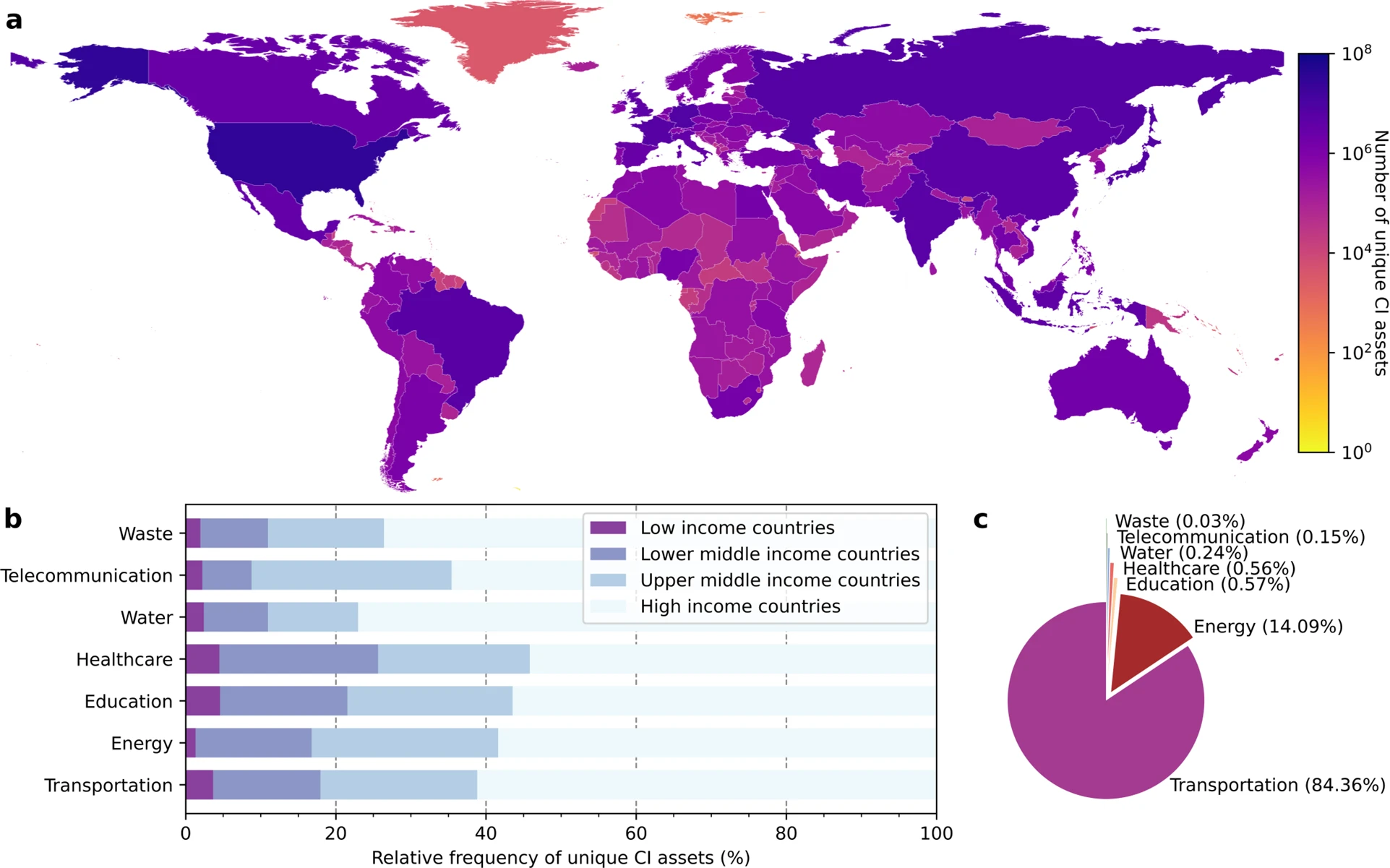Critical Infrastructure Explained#
Critical Infrastructure (CI) refers to the essential services and assets that form the backbone of a functioning society and economy. These infrastructure systems are vital for public health, safety, and economic well-being, supporting various activities ranging from transportation to energy distribution. CI systems are susceptible to a wide range of threats, both natural and human-made, including natural disasters, terrorism, and poor maintenance. We categorize critical infrastructure (CI) network into seven overarching systems: transportation, energy, water, waste, telecommunication, education, and health. This classification aligns with widely accepted frameworks in the literature (Hallegatte et al., 2019; Hall et al., 2019; Thacker et al., 2019; United Nations Office for Disaster Risk Reduction, 2015), and highlights the growing recognition of the importance of educational and health-related infrastructure (United Nations Office for Disaster Risk Reduction, 2015).
To represent the global landscape of CI, a total of 81 OpenStreetMap (OSM) tags were selected to identify 39 different infrastructure types (Popescu & Simion, 2011). This breakdown of critical infrastructure types enables a more granular approach to risk and damage assessments by providing detailed categorizations and geospatial data on the global infrastructure network.
 Figure 1: Distribution and statistics of unique CI assets extracted from OSM (Nirandjan et al., 2022).
Figure 1: Distribution and statistics of unique CI assets extracted from OSM (Nirandjan et al., 2022).
The spatial distribution of critical infrastructure assets varies across countries and income levels. Figure 1 illustrates this distribution across space and provides statistics for unique CI assets extracted from OpenStreetMap (OSM). Panel (a) shows the number of unique CI assets per country, revealing that the highest number of unique assets is found in high-income countries such as the United States, Germany, and Japan, while the lowest number is observed in Small Island Developing States (SIDS) and other small islands. Panel (b) breaks down the percentage of unique CI assets according to four income classes, categorized by the seven main CI systems. It shows that high-income countries account for 60.8% of the extracted OSM elements, while low-income countries contribute only 3.3%. Panel (c) illustrates the dominant role of the transportation system in the extracted CI elements, accounting for 84% of all unique assets. This dominance is largely due to the vast number of roads, particularly tertiary roads, which make up the bulk of the transportation infrastructure.
More specifically, we categorize CI into the following types and subtypes:
Transportation
The transportation system includes three subsystems: roads, railways, and airports. Roadways are further categorized into primary, secondary, and tertiary roads, with tertiary roads making up the majority of assets. The system facilitates the movement of people, goods, and services, and its disruption can cause widespread economic and societal impacts. Critical infrastructure types include:Roads (primary, secondary, tertiary)
Railways
Airports
Energy
The energy infrastructure is crucial for the generation, transmission, and distribution of electricity. The seven key types selected for energy representation include cables, power lines (major and minor), substations, and power plants. Disruptions to this system can result in significant economic losses and widespread outages. Key elements include:Power cables
Power lines
Minor power lines
Power towers
Power poles
Power plants
Substations
Telecommunication
Telecommunication networks enable communication through telephone, radio, and internet systems. This system includes communication towers and masts. Towers are generally taller and support multiple applications, while masts are used for single applications. Key infrastructure types include:Communication towers
Masts
Water
The water system provides the infrastructure needed to supply clean and potable water. The five selected infrastructure types are critical for the extraction, distribution, and storage of both potable and non-potable water. Critical components include:Water towers
Water wells
Covered reservoirs
Reservoirs
Water works
Waste Management
The waste management system is divided into two subsystems: solid waste and water waste. The solid waste subsystem consists of transfer stations and landfills, while the water waste subsystem includes water treatment plants. This system ensures proper disposal and treatment of waste materials. Key infrastructure includes:Waste transfer stations
Landfills
Water waste treatment plants
Health
Health infrastructure supports public health and medical services, ensuring the availability of hospitals, clinics, and pharmacies. A variety of facilities are considered under this system, ranging from general medical services to specialized centers. Examples include:Hospitals
Clinics
Pharmacies
Doctors
Laboratories
Birthing centers
Rehabilitation centers
Education
Educational infrastructure ensures the availability of facilities for learning and knowledge dissemination. The five infrastructure types in this system include:Schools
Universities
Colleges
Kindergartens
Libraries
As part of our damage and risk assessments, understanding these infrastructure types and their vulnerabilities is crucial. In the sections that follow, we will explore how each CI system can be assessed for risks and damages caused by natural threats.
